仁爱版九年级英语上第二单元教案
- 格式:doc
- 大小:76.00 KB
- 文档页数:13
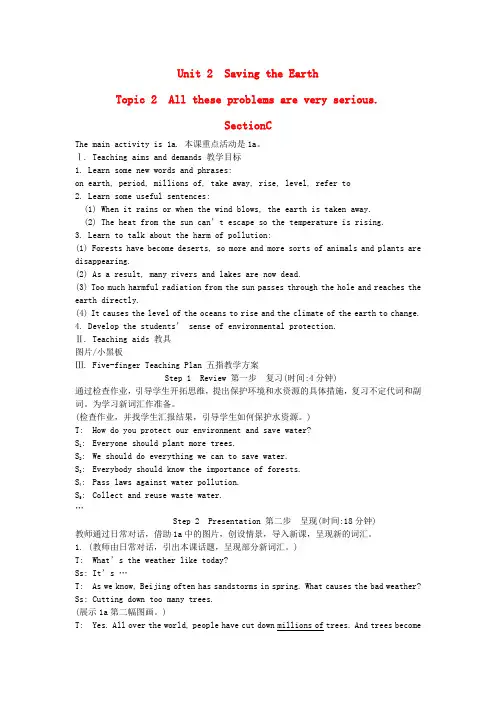
Unit 2 Saving the EarthTopic 2 All these problems are very serious.SectionCThe main activity is 1a. 本课重点活动是1a。
Ⅰ. Teaching aims and demands 教学目标1. Learn some new words and phrases:on earth, period, millions of, take away, rise, level, refer to2. Learn some useful sentences:(1) When it rains or when the wind blows, the earth is taken away.(2) The heat from the sun can’t escape so the temperature is rising.3. Learn to talk about the harm of pollution:(1) Forests have become deserts, so more and more sorts of animals and plants are disappearing.(2) As a result, many rivers and lakes are now dead.(3) Too much harmful radiation from the sun passes through the hole and reaches the earth directly.(4) It causes the level of the oceans to rise and the climate of the earth to change.4. Develop the students’ sense of environmental protection.Ⅱ. Teaching aids 教具图片/小黑板Ⅲ. Five-finger Teaching Plan 五指教学方案Step 1 Review 第一步复习(时间:4分钟)通过检查作业,引导学生开拓思维,提出保护环境和水资源的具体措施,复习不定代词和副词。
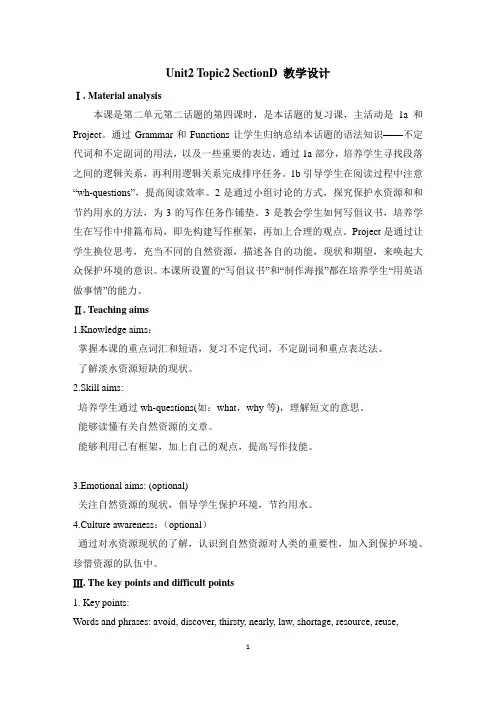
Unit2 Topic2 SectionD 教学设计Ⅰ. Material analysis本课是第二单元第二话题的第四课时,是本话题的复习课,主活动是1a和Project。
通过Grammar和Functions让学生归纳总结本话题的语法知识——不定代词和不定副词的用法,以及一些重要的表达。
通过1a部分,培养学生寻找段落之间的逻辑关系,再利用逻辑关系完成排序任务。
1b引导学生在阅读过程中注意“wh-questions”,提高阅读效率。
2是通过小组讨论的方式,探究保护水资源和和节约用水的方法,为3的写作任务作铺垫。
3是教会学生如何写倡议书,培养学生在写作中排篇布局,即先构建写作框架,再加上合理的观点。
Project是通过让学生换位思考,充当不同的自然资源,描述各自的功能,现状和期望,来唤起大众保护环境的意识。
本课所设置的“写倡议书”和“制作海报”都在培养学生“用英语做事情”的能力。
Ⅱ. Teaching aims1.Knowledge aims:掌握本课的重点词汇和短语,复习不定代词,不定副词和重点表达法。
了解淡水资源短缺的现状。
2.Skill aims:培养学生通过wh-questions(如:what,why等),理解短文的意思。
能够读懂有关自然资源的文章。
能够利用已有框架,加上自己的观点,提高写作技能。
3.Emotional aims: (optional)关注自然资源的现状,倡导学生保护环境,节约用水。
4.Culture awareness:(optional)通过对水资源现状的了解,认识到自然资源对人类的重要性,加入到保护环境、珍惜资源的队伍中。
Ⅲ. The key points and difficult points1. Key points:Words and phrases: avoid, discover, thirsty, nearly, law, shortage, resource, reuse,take sth. away from…, the shortage of water / water shortage, avoid (doing) sth., make progress in, nearly 3/4 of…2. Difficult points:学会归纳话题中的重点语法和表达法。
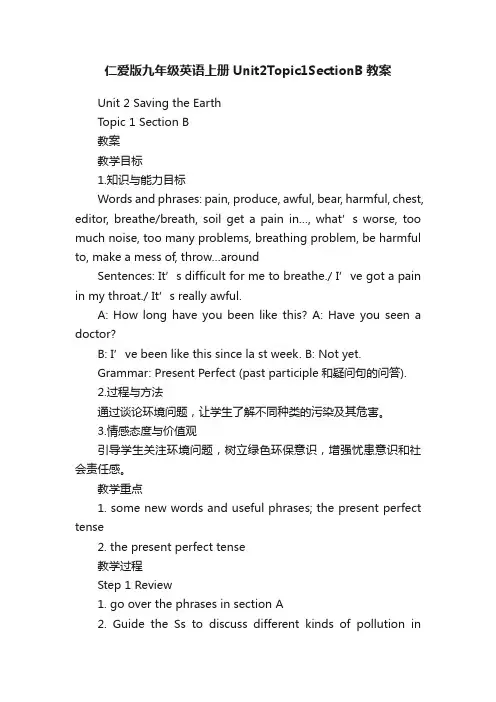
仁爱版九年级英语上册Unit2Topic1SectionB教案Unit 2 Saving the EarthTopic 1 Section B教案教学目标1.知识与能力目标Words and phrases: pain, produce, awful, bear, harmful, chest, editor, breathe/breath, soil get a pain in…, what’s worse, too much noise, too many problems, breathing problem, be harmful to, make a mess of, throw…aroundSentences: It’s difficult for me to breathe./ I’ve got a pain in my throat./ It’s really awful.A: How long have you been like this? A: Have you seen a doctor?B: I’ve been like this since la st week. B: Not yet.Grammar: Present Perfect (past participle和疑问句的问答).2.过程与方法通过谈论环境问题,让学生了解不同种类的污染及其危害。
3.情感态度与价值观引导学生关注环境问题,树立绿色环保意识,增强忧患意识和社会责任感。
教学重点1. some new words and useful phrases; the present perfect tense2. the present perfect tense教学过程Step 1 Review1. go over the phrases in section A2. Guide the Ss to discuss different kinds of pollution ingroups and share the answer together. Step 2 Presentation1. Watch the flash, then answer the questions below.1) Does Bruce look well?2) What’s wrong with him?3) How long has he been like this?4) Has he seen a doctor?2. Show a picture of the polluted West Hill, let the Ss listen to 1a once and tick the questions they hear in part A of 1b. Then check the answers together.A. Listen to 1a and check the questions you hear.1) What’s wrong with you?2) How long have you been like this?3) Where have you been?4) Have you seen a doctor?5) Have you noticed the dead fish in the river?B. Listen again and match each question above with an answer below.3. Read 1a and answer the questions.1) What caused Mrs. Zhou’s problems?2) What will Kangkang do?Step 3 Consolidation1.分角色朗读2a,选择四组进行比赛,激发学生朗读兴趣。
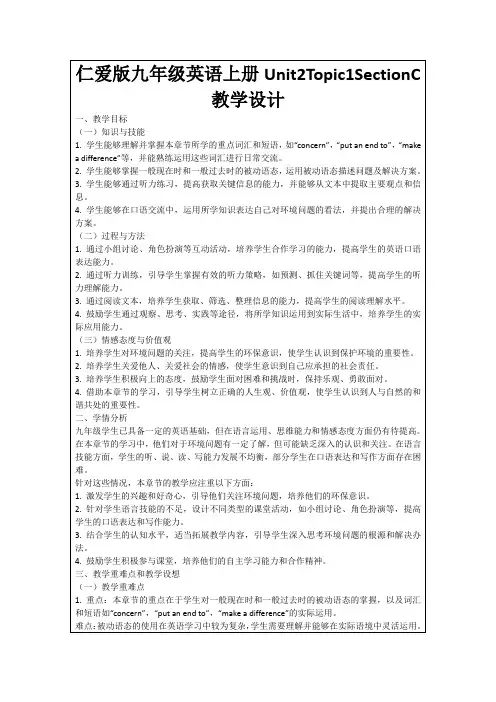
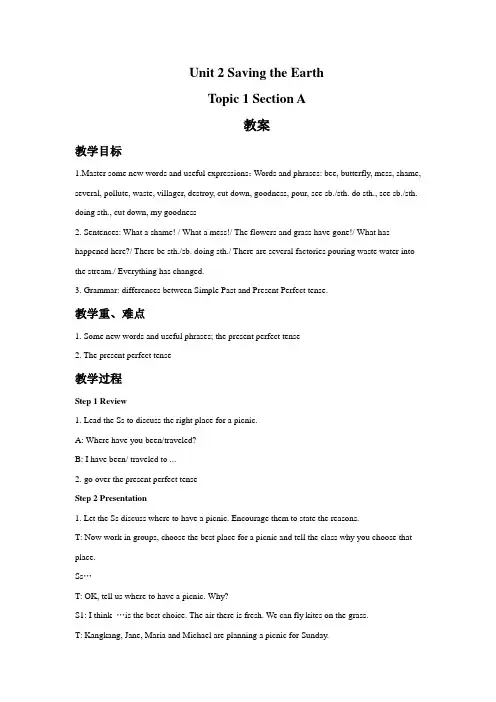
Unit 2 Saving the EarthTopic 1 Section A教案教学目标1.Master some new words and useful expressions:Words and phrases: bee, butterfly, mess, shame, several, pollute, waste, villager, destroy, cut down, goodness, pour, see sb./sth. do sth., see sb./sth. doing sth., cut down, my goodness2. Sentences: What a shame! / What a mess!/ The flowers and grass have gone!/ What has happened here?/ There be sth./sb. doing sth./ There are several factories pouring waste water into the stream./ Everything has changed.3. Grammar: differences between Simple Past and Present Perfect tense.教学重、难点1. Some new words and useful phrases; the present perfect tense2. The present perfect tense教学过程Step 1 Review1. Lead the Ss to discuss the right place for a picnic.A: Where have you been/traveled?B: I have been/ traveled to ...2.go over the present perfect tenseStep 2 Presentation1. Let the Ss discuss where to have a picnic. Encourage them to state the reasons.T: Now work in groups, choose the best place for a picnic and tell the class why you choose that place.Ss…T: OK, tell us where to have a picnic. Why?S1: I think …is the best choice. The air there is fresh. We can fly kites on the grass.T: Kangkang, Jane, Maria and Michael are planning a picnic for Sunday.They will go to the West Hill.2. Present two pictures of the West Hill and describe the changes. Teach the new words and some difficult sentences.3. Point to the bees and butterflies, and then write down the words and phrases on the BbStep 3 Practice1. …怎么样?What about…?2. 看见某人正在做某事see sb doing sth3. 真是一团糟!What a mess!4. 味道很难闻。
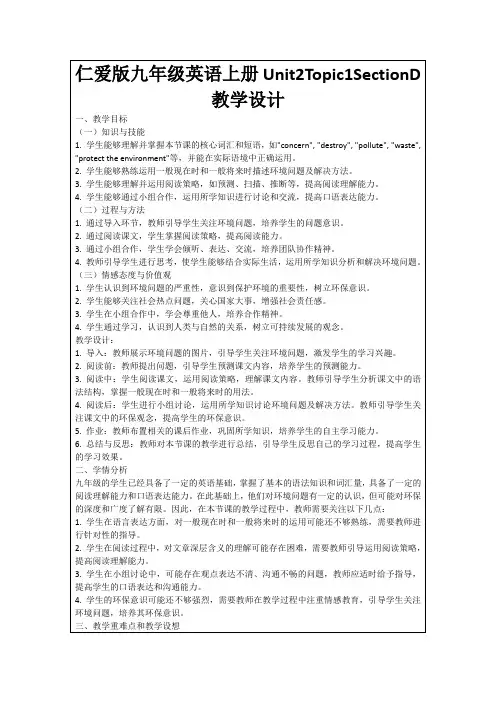
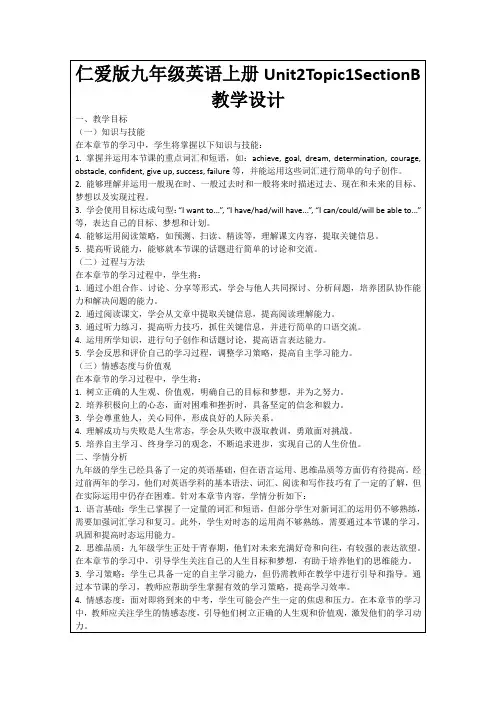
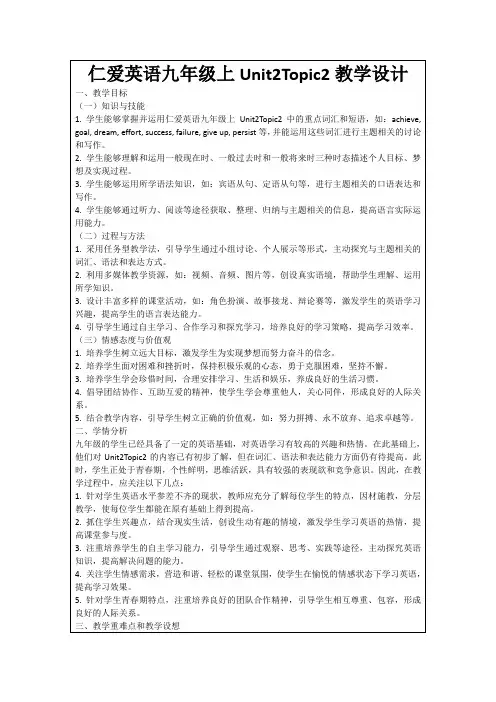
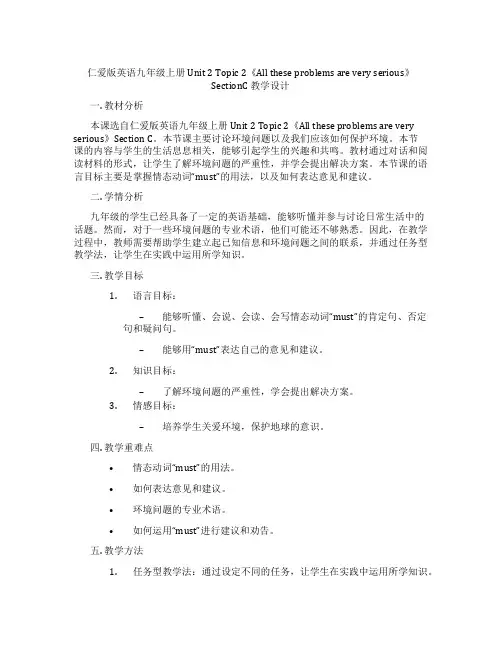
仁爱版英语九年级上册Unit 2 Topic 2《All these problems are very serious》SectionC 教学设计一. 教材分析本课选自仁爱版英语九年级上册Unit 2 Topic 2《All these problems are very serious》Section C。
本节课主要讨论环境问题以及我们应该如何保护环境。
本节课的内容与学生的生活息息相关,能够引起学生的兴趣和共鸣。
教材通过对话和阅读材料的形式,让学生了解环境问题的严重性,并学会提出解决方案。
本节课的语言目标主要是掌握情态动词“must”的用法,以及如何表达意见和建议。
二. 学情分析九年级的学生已经具备了一定的英语基础,能够听懂并参与讨论日常生活中的话题。
然而,对于一些环境问题的专业术语,他们可能还不够熟悉。
因此,在教学过程中,教师需要帮助学生建立起已知信息和环境问题之间的联系,并通过任务型教学法,让学生在实践中运用所学知识。
三. 教学目标1.语言目标:–能够听懂、会说、会读、会写情态动词“must”的肯定句、否定句和疑问句。
–能够用“must”表达自己的意见和建议。
2.知识目标:–了解环境问题的严重性,学会提出解决方案。
3.情感目标:–培养学生关爱环境,保护地球的意识。
四. 教学重难点•情态动词“must”的用法。
•如何表达意见和建议。
•环境问题的专业术语。
•如何运用“must”进行建议和劝告。
五. 教学方法1.任务型教学法:通过设定不同的任务,让学生在实践中运用所学知识。
2.情境教学法:通过创设情境,让学生在真实的语境中学习英语。
3.合作学习:通过小组讨论和分享,培养学生团队合作的能力。
六. 教学准备1.教师准备:–备课教案。
–相关环境问题的图片和视频。
–录音机和磁带。
2.学生准备:–预习相关单词和短语。
–准备好讨论环境问题的意见和建议。
七. 教学过程1.导入(5分钟)教师通过展示一些环境问题的图片和视频,引导学生关注环境问题,并激发学生的学习兴趣。
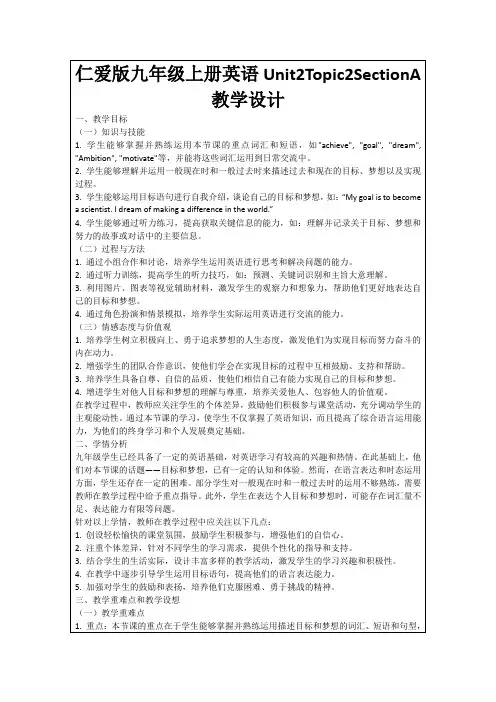

仁爱版英语九年级上册unit2教案教案要面向全体学生,关注每个学生的情感,激发他们学习英语的兴趣,帮助他们建立学习的成就感和自信心,使他们在学习过程中发展综合语言运用能力,下面是我给大家整理的仁爱版英语九年级上册unit2教案5篇,希望对大家能有所帮助!仁爱版英语九年级上册unit2教案1Unit1TheDevelopingWorldTopic1ChinahasdevelopedrapidlyInrecentyears.SectionAThemainactivityis1a.本课重点活动是1a。
Ⅰ.Teachingaimsanddemands教学目标1.Learnsomenewwordsandaphrase:proper,bytheway,bell,grandpa,chairwoman,grandson2.Learnausefulsentence:Theregoesthebell.3.Learnthepresentperfecttense:(1)Rita,youhavejustcomebackfromyourhometown.(2)—Wherehaveyoubeen,Jane?—IhavebeentoMountHuangwithmyparents.(3)—Bytheway,where’sMaria?—ShehasgonetoCubatobeavolunteer…4.Taltthechildren’svacationexperiences.Ⅰ.Teachingaids教具录音机/小黑板/学生的旅游纪念照/图片/幻灯片Ⅰ.Five-fingerTeachingPlanStep1Review通过教师询问学生的暑期活动,导入话题,呈现部分生词。
T:Listen!Thebellisringing.Let’sbeginourclass!(教师解释Thebellisringing等于Theregoesthebell,板书bell,要求学生掌握。
Unit2 Saving the EarthTopic2 All these problems are very seriousSectionB一.教材分析本节课选自仁爱版英语九年级上册Unit2Topic2 All these problems are very serious SectionB.本课以讲树木的作用以及砍树的危害----形成沙尘暴的原因,以关于环境保护为中心话题。
通过描述贴近生活的事件,向学生展示环境破坏的危害。
本人结合教学实际在教材上作了适当的调整,使教学内容符合学生实际认知水平,借助于沙尘暴的视频和相关的图片,导入本课话题,让学生了解沙尘暴形成的原因,人们砍树的危害并进行语言知识的操练与巩固,接着引入树木的功能,过度到保护森林和水资源的重要性,以培养学生的环保意识。
一.教学思路本课以热点话题环境保护为中心话题,通过有效地教学手段,激发和培养学生学习英语的兴趣,养成良好的学习习惯并形成有效地学习策略,发展自主学习的能力和合作精神,始终贯彻“用中学,学中用”学用结合,学以致用的原则,教学方法多样,根据教材和教学的需要采用了直观法,任务型教学法,活动教学法和交际法,同时教师指导学生学会导学自悟的学习方法。
教学过程中始终贯彻以学生为主体,教师为主导,训练为主线,能力为目标的教学理念,做到课堂教学活动化,教学任务活动化,活动任务具体化,让学生在教师的指导下,通过感知,体验,实践,参与和合作等方式,实现一个个任务的目标,,感受成功。
在学习过程中进行情感和策略的调整,以形成积极的学习态度,促进语言实际运用能力的提高。
一.教学目标(一)知识目标1. 1. Learn some new words and phrases:sand, cut down, change into, prevent, prevent … from, human being, although, law, turn off2. Learn some useful sentences:(1) I couldn’t see anything.(2) As a result, a lot of rich land has changed into desert.(3)Trees can stop the wind from blowing the earth away./Theycan also prevent the water from washing the earth away.(4) A lot of water can be saved by forests(5)Cutting down trees is harmful to human beings, animals andplants.(6) Pass laws against water pollution.(7) Remember to turn the tap off when you leave.3. Continue to learn the indefinite pronoun and adverb.4. Learn to talk about pollution and its harm.(二)技能目标1.学生通过语言知识的呈现及输入和感知的同时进行不同形式的操练,从而达到语言知识的熟练运用。
课文标题:All these problems are very serious. 单元名称:Unit2 Topic 2 SectionA教材版本:科普版授课年级:九年级整体设计思路1. 本课通过谈论沙尘暴的成因说明了树木对环境保护的重要作用,引导学生树立人与自然和谐共生的主题。
2. 通过四大导图和看(know er)、听(listener)、读(reader)、说(speaker)、写(writer),五重角色发展五大技能。
教学目标1. 学生能听读对话内容,用英语表达如何保护树、保护自然、保护环境的意识。
2. 听说课两大任务:理解性技能、表达性技能。
3. 学习能力的培养和导教、导学、导评的目标意识达成。
教学重难点1.talk about the functions of trees and how to protect trees2.create and explain the mind-maps教学过程教学步骤教师活动学生活动设计意图及资源准备Step1: Lead-in Show Ss their learningobjectives.Get to know theirlearning objectives呈现学习目标以树立学生的目标意识。
Compare differentconditions by showingpics.Look atthepictures andexperience thedifferent weatherconditions.通过绶溪美景导入环境问题,播放与沙尘暴相关视频,从视觉、听觉等方面感知沙尘暴这种恶劣的天气现象。
Show Ss a video aboutsandstormWatch the videoand answer twoquestions.Step2: I am a knower Show 6 pics andphrases and presentthe question,lead Ssto number the pics ina correct order andtalk about them.1.Look and talkabout howsandstorms comeinto being.2.Number thepic into a correctorder and tell thereason.发展“看”的技能。
精选范本
Unit 2 Saving the Earth
Topic 1 Pollution has caused too many problems.
Section A
Ⅰ. Material analysis
本课是九年级第二单元第一话题的第一课时。
主活动是1a 。
1a 通过对比“West Hill”今昔的环境变化,引出本话题的污染问题,巩固现在完成时与一般过去时的用法及区别。
1b 要求学生能够听懂一般过去时态和现在完成时态,也就是要分清1b 所提及的词语所伴随的时间。
1c 则是在阅读之后再找出“西山”所发生的变化。
2通过观察图片内容,结对编对话,描述污染前后的情况,进一步训练学生口头表达能力和对一般过去时和现在完成时的运用能力。
3通过听并记录“动物的生存现状”,了解环境污染带给动物的危害,继续提高学生的听力水平。
任务4的口语表达,培养学生的说的技能,检测对本课的掌握情况。
通过本课的学习,培养学生关注环境问题的意识。
Ⅱ.Teaching aims 1.Knowledge aims :
掌握本课的重点词汇和短语,巩固一般过去时和现在完成时的用法和区别。
能够用一般过去时和现在完成时描述过去和现在的变化。
正确使用there be sth./sb. doing sth.来表达“有某人/物正在做某事”。
2.Skill aims:
能听懂描述环境变化的对话,区别一般过去时和现在完成时的用法。
能理解和运用一般过去时和现在完成时来进行听、说、读、写活动。
3.Emotional aims: (optional)
让学生了解环境污染的严重性,并树立环保意识。
4. Culture awareness: (optional)
通过课文的学习,让学生了解环境的变化,关注全球的环境问题。
Ⅲ. The key points and difficult points
1. Key points:
Words and phrases: bee, butterfly, mess, shame, several, pollute, waste, villager, destroy, cut down, goodness, pour, see sb./sth. do sth., see sb./sth. doing sth., cut down, my goodness
Sentences: What a shame! / What a mess!
The flowers and grass have gone!
What has happened here?
There be sth./sb. doing sth.
There are several factories pouring waste water into the stream.
精选范本
Everything has changed.
Grammar: differences between Simple Past and Present Perfect tense.
2.Difficult points:
正确使用there be sth./sb. doing sth.来表达“有某人/物正在做某事” 。
区别使用短语see sb./ sth. do sth.和 see sb. / sth. doing sth.。
能正确地以口头和书面形式区别使用一般过去时和现在完成时。
Ⅳ. Learning strategies
通过引导学生在听前阅读1b和3,培养学生形成听前熟悉、预测听力材料的习惯。
通过朗读1a和2,引导学生模仿已有对话,编写新的对话。
通过1c,培养学生整合对话信息,将对话转换为语篇的能力。
Ⅴ. Teaching aids
图片(关于校园周边环境变化对比图或者影像资料),录音机,幻灯片等。
Ⅵ. Teaching procedures
精选范本
精选范本
精选范本
精选范本。